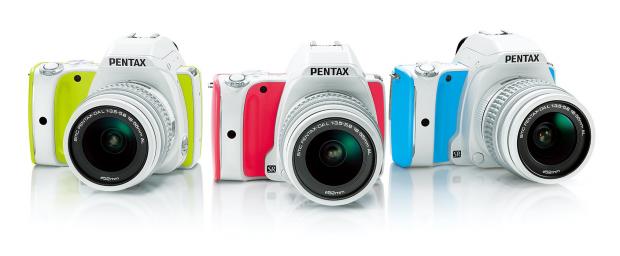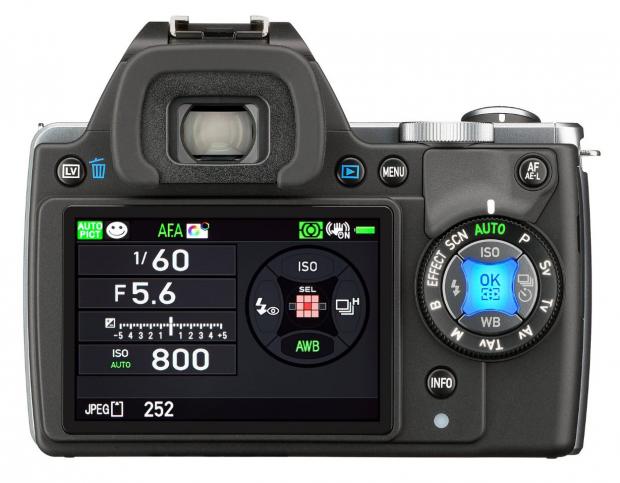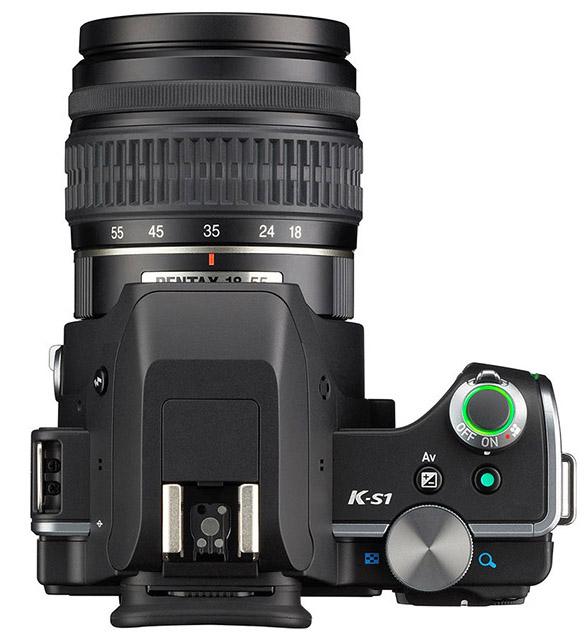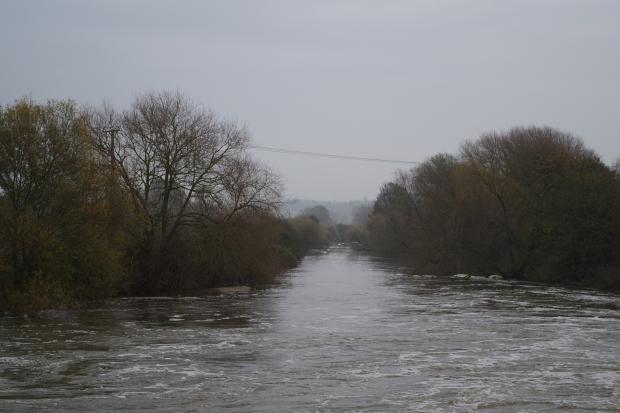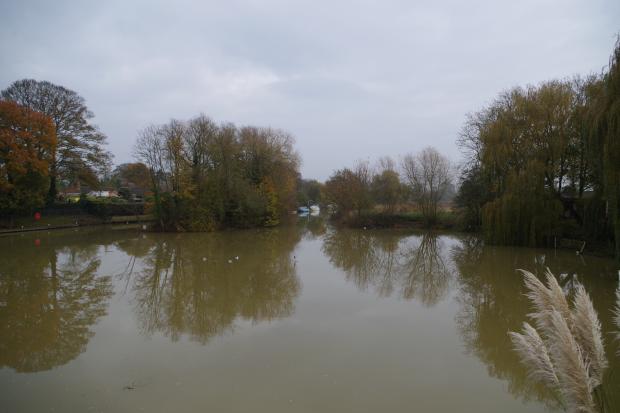Pentax K-S1 review
Pentax has a relatively small share of the SLR market compared to Canon and Nikon, but that possibly explains why it’s not afraid to try something bold to shake things up. SLRs don’t get much bolder than the K-S1, which is available in a choice of 15 colour schemes with names such as Tweed, Dusk Gold and Strawberry Cake. Then there’s the assortment of LEDs dotted around the camera. The shutter button glows green for photos, red for videos, and the rear OK button has a bright blue backlight. The mode dial encircles the navigation pad on the back of the camera – an unusual location that we didn’t really take to – and its labels glow white while the selected mode changes to green.
There’s also the strip of green LEDs down the front of the hand grip. They’re mostly just for show, but become more useful when displaying a visual countdown in self-timer mode. They can also show how many faces have been detected in live view mode, which might be useful for ensuring your friends are all crammed into a selfie shot. It would make more sense if the camera could be programmed to take a photo automatically when a certain number of faces have been detected. We suspect that K-S1 owners are more likely to be taking family portraits with a tripod rather than selfies in nightclubs.
^ The Sweets Collection: choose between Lime Pie, Strawberry Cake and Blue Cream Soda
Underneath all those colours and lights, the K-S1 is a fairly conventional digital SLR, with much in common with the superb Pentax K-50. The viewfinder is significantly bigger than those found in rival consumer SLRs, and much closer in size to upmarket models such as the Canon EOS 70D. The 1/6,000s top shutter speed is faster than its rivals, too.
There are relatively few buttons but they’re well used, with functions sensibly grouped together for quick access. For example, pressing the ISO button reveals both a manual ISO speed control and the ability to adjust the range of the Auto ISO function. The flash mode control includes quick access to flash compensation. The Info button reveals 15 functions in a grid, which can be navigated with the rear pad and adjusted with the command dial. We particularly like the ability to shoot JPEGs but retrospectively save a RAW file of the last frame.
VIDEO QUALITY
We complained about the lack of HDMI on the K-50 so it’s good to have it included here. There’s no Wi-Fi, though, and the 3in screen is neither articulated nor touch-sensitive. Autofocus is finally available in video mode, but it’s not a full-time autofocus. Instead, it must be triggered using the AF AE-L button. Doing so spoiled the soundtrack as it shuttled back and forth trying to regain focus.
This wasn’t the only issue we spotted with the K-S1’s videos. There were pronounced aliasing artefacts such as moiré interference on repeating patterns, and more noise than we’d expect from a large sensor. Rolling shutter effect was quite pronounced, skewing geometry of fast-moving subjects or when quickly panning the camera. The sensor-based stabilisation behaved slightly oddly for videos, too. None of these issues was disastrous but we wouldn’t recommend this camera to keen videographers.
Photo performance was excellent, taking less than 0.4 seconds between shots in normal use, although it slowed after 10 frames to 0.8 seconds for RAW capture. Autofocus was decisive but the 11-point autofocus sensor can’t compete with the 39 points on the Nikon D5300. The spritely performance of the K-S1’s live view autofocus goes some way to compensating, though. The autofocus point can be positioned freely in live view mode, and there’s responsive subject tracking on offer too. Continuous shooting was at 5.1fps for 19 JPEGs or six RAW frames before slowing to the speed of the card. That’s in line with the performance of the Nikon D5300 and Canon EOS 700D.
AA FILTER SIMULATOR
The K-S1’s most unusual feature is its anti-alias (AA) filter simulator. Often known as an optical low-pass filter (OLPF), an AA filter blurs the image very slightly to avoid aliasing artefacts such as blocky details and swirling interference known as moiré. AA filtering is usually performed by an optical component sat just in front of the sensor. There has been a trend towards removing the AA filter from SLRs’ sensors in recent years, which boosts sharpness a little but also increases the risk of these unwanted artefacts. In practice, though, we’ve found both the benefit and the drawbacks to be extremely subtle.
The K-S1 doesn’t have an AA filter, but it can simulate the effect using its sensor-based optical stabilisation. Essentially, it gives the sensor a slight shake as it’s capturing a photo to achieve the same effect. This means the user can choose whether or not to use it. There’s even a bracketing mode that takes three frames in quick succession with three different AA filter settings. Ultimately, though, the difference between the various settings was at best extremely subtle, and often imperceptible.
IMAGE QUALITY
Otherwise, the K-S1 put in a solid performance in our image quality tests. Automatic exposures were hard to fault, and colours in JPEGs were lifelike at default settings. The kit lens’ focus deteriorated slightly towards the left edge of wide-angle shots but it was much better at the telephoto end of the zoom.
The 20-megapixel sensor delivered plenty of detail, regardless of the AA filter setting. We were able to eke out slightly more fine detail by running RAW files through Lightroom, but those who prefer to shoot JPEG won’t be disappointed.
Noise levels compared well with its rivals. Both the JPEG and RAW output exhibited less noise at ISO 6400 than the Canon EOS 700D, and it was on a par with the Nikon D5300 for RAW. The Nikon’s JPEGs had a slight advantage, though, with less chroma noise in shadows. The K-S1’s image quality fell apart at ISO 12800 and 25600, with details becoming extremely vague. Overall, the Nikon D5300 takes a narrow lead for image quality, but all three are pretty close and it’s not something that would strongly influence our buying decision.
^ Focus is sharp and the long end of the zoom, and these subtle fine details have been handled well . (1/100s, f/5.6, ISO 100, 82mm equivalent)
^ Wide-angle shots aren’t quite as sharp, particularly towards the left edge of the frame. (1/100s, f/5.6, ISO 100, 27mm equivalent)
^ Shooting at dusk has pushed the ISO speed up to 3200. Fine details have suffered but it’s a respectable snapshot. (1/100s, f/5.6, ISO 3200, 82mm equivalent)
^ There’s a fair amount of grain at ISO 6400 but it’s not too intrusive and colours are balanced. (1/30s, f/4, ISO 6400, 36mm equivalent)
^ Image quality drops significantly at ISO 12800, with blotchy grain and barely any fine detail. (1/100s, f/5.6, ISO 12800, 72mm equivalent)
CONCLUSION
The K-S1 is a welcome improvement on last year’s Pentax K-50 and Pentax K-500. It costs a little less than the K-50 did at launch, and while it lacks weather sealing, it’s not hobbled in other ways as the entry-level K-500 was. The K-50 remains a tempting proposition, though, currently available for around £400.
It’s a shame that Pentax’s efforts to shake off its conservative reputation concentrates on cosmetics rather than technology. The Canon EOS 700D has an articulated touchscreen, smooth video autofocus and off-camera flash control. TheNikon D5300 also has an articulated screen plus Wi-Fi, GPS and a 39-point autofocus system. The K-S1 has a novel but ultimately insignificant AA filter simulator, comes in a choice of colours and is covered in lights. Then again, it also costs slightly less and its big viewfinder might well be the trump card that seals the deal. Despite its appearance, this is a camera for people who want to take photos the old fashioned way. In that respect, it does a fine job.


